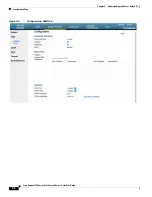
2-12
Cisco Aironet 1810 Series OfficeExtend Access Point User Guide
Chapter 2 Understanding the Access Point GUI
Configuration Page
–
SNMP
–
HTTPS
Select the required protocol for the rule by choosing it from the
Protocol
drop-down list.
•
Set the rule to filter the traffic to specified destination port range, or to TCP or UDP ports as a whole.
Depending on your requirement, you can use the
Destination Port Range
fields, or select
TCP
or
UDP
from the
Protocol
drop-down list.
•
Set the rule as an allow or disallow rule for the combination of the aforementioned parameters.
Check the
Allow
check box to make this an allow rule. Else, uncheck it.
Port Forwarding
The Port Forwarding settings allow you to configure port forwarding rules for packets from WAN port
to Local LAN clients and back. A maximum of 10 Port Forwards can be set, but their ranges should be
of the same size and should not overlap. For each rule you can set the following parameters:
•
Protocol—You select either of the following options as per your requirements:
–
Select
TCP
or
UDP
and then set the
WAN Port Start
and
WAN Port End
values.
–
Select one of these protocols— FTP, Telnet, SMTP, DNS, TFTP, HTTP, POP3, NNTP, SNMP,
or HTTPS
•
WAN port range—You can manually set this, using the
WAN Port Star
t and
WAN Port End
fields,
only if the protocol is specified as TCP or UDP. For all other protocols this range displays the
pre-configured port number.
•
Local IP address—Specify the Local LAN client IP Address where the traffic is to be forwarded to.
•
LAN port range—Set this range using the
Local Port Start
and
Local Port End
fields.
DMZ
The DMZ feature allows one network computer connected to a local LAN or WLAN to be exposed to
the Internet for using special-purpose services such as Internet gaming. The DMZ feature forwards all
the ports terminating on a WAN IP, which is set as the
DMZ IP Address
, at the same time to one PC.
The DMZ feature, if enabled, will forward all incoming WAN packets to the LAN machine, except the
CAPWAP control/data and packets which are destined to any ports and which have a port forwarding
rule. The DMZ feature is not applicable to corporate networks such as Remote-LAN and Corp WLAN.
However, the Port Forwarding feature is more secure, compared to DMZ feature because the former only
opens the ports you want to have opened, while DMZ opens all the ports of one computer, exposing the
computer to the Internet/WAN.



















